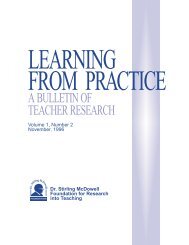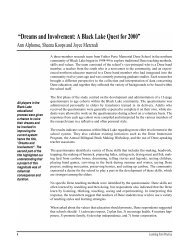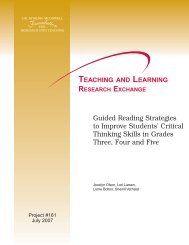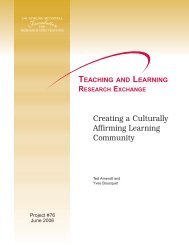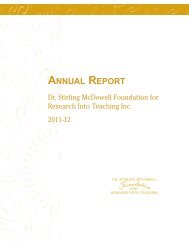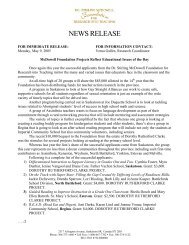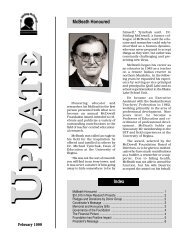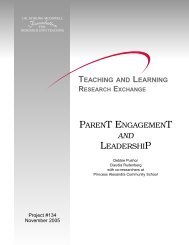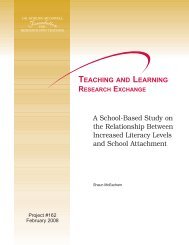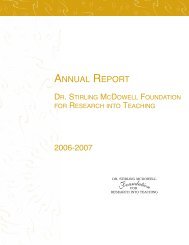Differentiated Instruction to Support Literacy in the Primary Grades
Differentiated Instruction to Support Literacy in the Primary Grades
Differentiated Instruction to Support Literacy in the Primary Grades
Create successful ePaper yourself
Turn your PDF publications into a flip-book with our unique Google optimized e-Paper software.
In The Beg<strong>in</strong>n<strong>in</strong>g<br />
The big questions <strong>in</strong> our m<strong>in</strong>ds were: why are many of <strong>the</strong> primary students not<br />
read<strong>in</strong>g well and what can we do <strong>to</strong> help <strong>the</strong>m<br />
We are Myra, Jenise and Cynthia, <strong>the</strong> Learn<strong>in</strong>g Assistance Teachers at Fa<strong>the</strong>r Vachon<br />
School <strong>in</strong> Saska<strong>to</strong>on, Saskatchewan. Our school has approximately 300 students<br />
from k<strong>in</strong>dergarten <strong>to</strong> grade eight with a diverse mix of cultures and socio-economic<br />
groups. Students with special needs are embraced and we have an early <strong>in</strong>tervention<br />
program for children with behavior problems. There is also a pre-school that is<br />
structured <strong>to</strong> support children <strong>in</strong> read<strong>in</strong>ess for school. Our school has a very<br />
car<strong>in</strong>g environment for all, students and staff. The adm<strong>in</strong>istration supports learn<strong>in</strong>g<br />
for students and encourages staff <strong>to</strong> reach beyond <strong>the</strong> norm and give more <strong>to</strong> our<br />
students, <strong>the</strong>refore becom<strong>in</strong>g better teachers. From this sett<strong>in</strong>g an application for a<br />
McDowell grant was submitted <strong>to</strong> study how <strong>to</strong> better teach <strong>the</strong> grade ones and twos<br />
read<strong>in</strong>g and writ<strong>in</strong>g.<br />
Our research question orig<strong>in</strong>ated from dialogue amongst ourselves about why <strong>the</strong><br />
grade ones did not have some of <strong>the</strong> basic skills required <strong>to</strong> meet <strong>the</strong> curriculum<br />
objectives. Our role <strong>in</strong> <strong>the</strong> school is <strong>to</strong> support classroom teachers <strong>in</strong> <strong>the</strong>ir <strong>in</strong>struction<br />
of students. We wondered how we could reach <strong>the</strong> students who struggled with<br />
basics, those who were “at grade” and those who were perform<strong>in</strong>g above expectations.<br />
Of course, all teachers encounter this dilemma, but we wanted <strong>to</strong> try ability<br />
group<strong>in</strong>g across grades, collaborat<strong>in</strong>g with all <strong>the</strong> staff work<strong>in</strong>g <strong>in</strong> <strong>the</strong> grade one and<br />
two classrooms. The team of people that we <strong>in</strong>volved were all very passionate,<br />
dedicated and open <strong>to</strong> new ideas.<br />
Myra, Jenise, and Cynthia led <strong>the</strong> team and each had a unique <strong>in</strong>sight and<br />
background <strong>to</strong> contribute <strong>to</strong> <strong>the</strong> work<strong>in</strong>gs of it all.<br />
• Myra had been at <strong>the</strong> school six years and worked closely with <strong>the</strong> grade one<br />
teacher. Toge<strong>the</strong>r <strong>the</strong>y had done work with small groups and guided read<strong>in</strong>g. She<br />
was concerned about <strong>the</strong> wide variance <strong>in</strong> that classroom and <strong>the</strong> struggle <strong>to</strong><br />
reach <strong>the</strong> bot<strong>to</strong>m and <strong>to</strong>p end of students without sacrific<strong>in</strong>g <strong>the</strong> learn<strong>in</strong>g of o<strong>the</strong>rs.<br />
• Jenise had been at <strong>the</strong> school ten years and noticed <strong>the</strong> grow<strong>in</strong>g demands on<br />
families and <strong>the</strong> chang<strong>in</strong>g demographics of <strong>the</strong> community that had brought<br />
students <strong>to</strong> school with greater needs. The needs of <strong>the</strong> children were not only<br />
academic, but social as well. She was <strong>in</strong>volved <strong>in</strong> <strong>the</strong> implementation of guided<br />
read<strong>in</strong>g and saw <strong>the</strong> use of <strong>the</strong> four blocks of literacy (Fountas and P<strong>in</strong>ell,<br />
1996) as a powerful learn<strong>in</strong>g model.<br />
• Cynthia had been at <strong>the</strong> school two years and immediately noticed <strong>the</strong> warmth<br />
of <strong>the</strong> staff. She felt it could be a safe place <strong>to</strong> explore and experiment with a new<br />
method of <strong>in</strong>struction <strong>to</strong> enhance learn<strong>in</strong>g.<br />
These three women worked exceptionally well <strong>to</strong>ge<strong>the</strong>r <strong>to</strong> see <strong>the</strong> process from<br />
<strong>in</strong>ception <strong>to</strong> completion. Each one gave of her talents and collaborated with <strong>the</strong> team<br />
<strong>in</strong> a sometimes whirlw<strong>in</strong>d of activity.<br />
RESEARCH REPORT: <strong>Differentiated</strong> <strong>Instruction</strong> <strong>to</strong> <strong>Support</strong> <strong>Literacy</strong> <strong>in</strong> <strong>the</strong> <strong>Primary</strong> <strong>Grades</strong><br />
1



